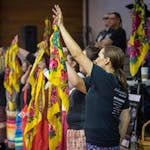The riots that gripped Minneapolis and the death of George Floyd at the hands of Minneapolis police have spurred something unexpected: Neighborhoods across the city have grown stronger.
From Little Earth and Longfellow, neighbors banded together at street corners, alleyways and intersections to protect their homes, businesses, grocery stores and churches from arsonists and looters.
Now neighborhoods, more mobilized and organized than ever, hope to leverage that fresh energy and unity to do good in the long-term — whether it's helping out neighbors more, fundraising or pushing for broader political and racial justice changes.
"We need to actually find ways to make sure this never happens again," said Pamela Twiss, 58, who lives in East Nokomis. "We want to continue to talk to each other."
In her south Minneapolis neighborhood, residents convened on the text and voice messaging app WhatsApp to report suspicious cars. They met at a church lawn daily for five days to discuss plans to protect their streets.
Now, they're sharing petitions and protest information, collecting food for a growing number of people in need after grocery stores burned to the ground and starting a discussion group on white fragility.
In Longfellow, after the violence subsided, neighbors stopped block patrols and barricading streets and vowed to push for longer term change such as making the community safer for people of color. In Powderhorn, as a helicopter buzzed overhead last week, residents said at a block meeting that the constant chats on their WhatsApp group was already doing some good — from sharing veterinarian tips to starting deeper conversations on issues such as decolonization.
And in north Minneapolis, where rival gang members and other residents teamed up to protect grocery stores and other businesses, residents hope to keep them engaged.
"It was the young guys who people spurn [who protected the North Side]; they deserve credit," said K.B. Brown, who spent many late nights until sunrise watching over his street in northeast Minneapolis as well as on the North Side. "They think the streets are all there is. We have the opportunity to show them there's much more. In the end, they got a taste of what it feels like ... to not be the pariah of the community and be the defender of the community."
Now, he said, they need to keep those young men engaged, litigate their "street beefs" and make sure they have concrete things to do. He said residents are also more mobilized about creating longer-term change on the North Side, increasing ownership of buildings and keeping more money in the community.
"Now we're focused on making sure we're in control of the transformation in our community," he said.
Meeting new neighbors
The unrest in Minneapolis comes at the same time the community has been hit hard by the COVID-19 pandemic.
But in south Minneapolis, the outbreak has actually allowed Melissa Hysing, 41, to meet more of her neighbors, who are staying home more. Then when authorities warned residents to look for suspicious water bottles or containers of accelerants, she scoured her alleyway's shrubs, running into other Standish neighbors doing the same.
"I've met more neighbors in the last 11 days than 11 years," Hysing said.
She quickly realized the block needed to be more organized and went door-to-door to gather information and connect over e-mails and texts. Now, she hopes neighbor conversations continue — whether it's socializing over a meat raffle in the alley or discussing city politics and countering racism.
"We're still in three compounding crises," she said of the pandemic, economic crisis and outcry for police reform following Floyd's death. "I think it will be up to all of us [to respond.]"
Nearby, David Yehl, 49, wanted to capitalize on his neighborhood's unity after standing watch at night over his street during the riots. So he and his neighbors grabbed leaf blowers and garden hoses, holding a car wash fundraiser.
Three hours and more than 100 cars later, they had raised more than $10,000 thanks to a corporate match, all going toward the Lake Street Council and the West Broadway Business and Area Coalition to rebuild damaged businesses in south and north Minneapolis.
"A lot of us felt really dejected," Yehl said. "We wanted to give some hope to the community."
His wife, Jennifer Kennard, is organizing a book club to read books on anti-racism and white privilege to continue the dialogue among neighbors.
"The entire neighborhood really came together because I think everyone understands the importance of what happened," he said.
A new energy
Neighborhood associations have been doing this kind of work for decades, said Candace Miller Lopez, executive director of the Standish Ericsson Neighborhood Association. But she said the new energy among residents and blocks is heartening.
Usually, when she holds board or information sessions, it's "crickets" but a recent gathering drew about 30 people.
"The work we've been doing all along is actually being elevated," she said, adding that the association is developing a block organizer tool kit to better help block leaders. "There's a greater sense of urgency."
She said the increased connections among neighbors will do good long-term — whether it's just connecting neighbors more to help someone mow their lawn after a surgery to mobilizing around bigger issues.
"People are realizing they have to be more engaged than normal," Miller Lopez said. "Now people are seeing we have the power to change things if we know our neighbors."
Kelly Smith • 612-673-4141



